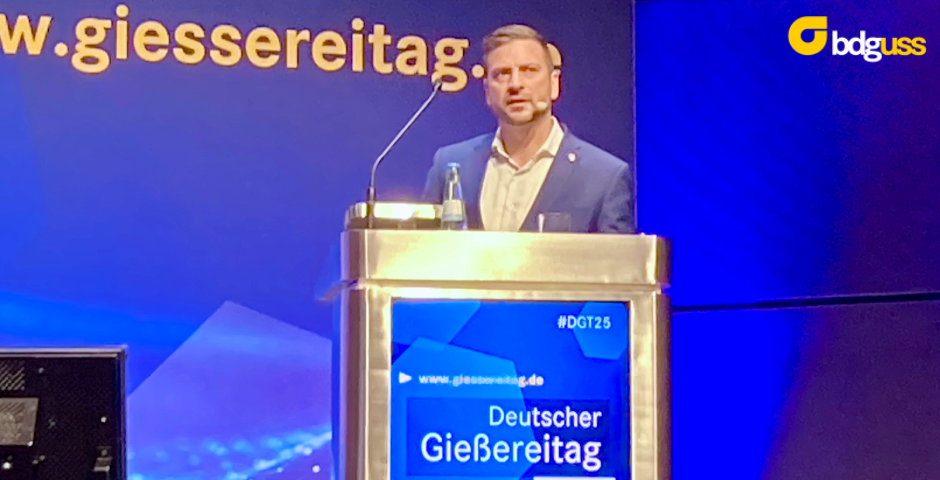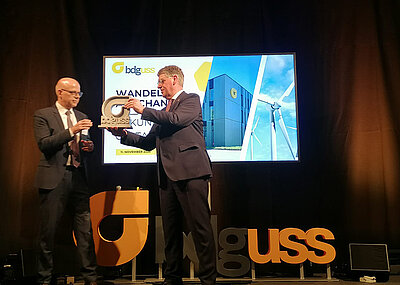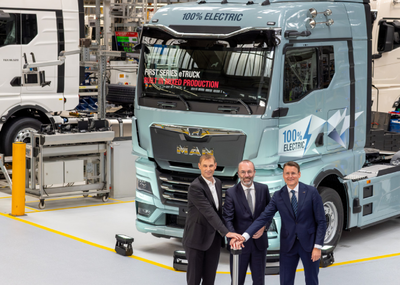The message was clear: purely human intelligence will no longer suffice – we need both. Those who fail to integrate artificial intelligence as a tool risk falling behind in a rapidly evolving manufacturing landscape.
From Computer Skepticism to AI Reality
As far back as 1985, the German Foundry Day debated the advent of the “computer age in the foundry.” Back then, skepticism ran high – yet today a foundry without digital systems is unthinkable. We are seeing a similar debate around AI today. But what still seems visionary now will likely become standard in just a few years: autonomous systems, assistive AI, and data-driven process optimization.
Four Drivers Accelerating the Transformation
Dr. Tewes emphasized that this transformation isn’t happening by chance – it is being dramatically accelerated by several global developments:
-
Global crises & supply chain bottlenecks: Companies must become more resilient and produce closer to home to weather disruptions.
-
Climate change & CO₂ pressure: Energy and resource efficiency are becoming critical factors for competitiveness.
-
Skilled labor shortage & demographic change: Without digital support, it will be hard to attract young talent and retain expertise as the workforce ages.
-
Digital disruption: Processes need to run faster, more precisely, and more efficiently – which calls for AI-based assistance systems at every level.
What Is Already Possible Today
The technology is already here – it just needs to be put to use:
-
Humanoid robots: Platforms such as Figure 01 or Optimus are beginning to take on autonomous production and logistics tasks.
-
Paperless AI systems in Chinese airports: They show how seamless user guidance can be, offering a preview of the experience future generations will expect even in industrial environments.
-
Vehicles become mobile devices
Foundries Under Pressure to Act
The pressure to act is immense:
-
The level of digitalization in many mid-sized foundries is only around 30%.
-
The availability of qualified personnel is declining – especially for engineers and technicians.
-
New employees need to be onboarded faster, and AI-assisted support systems can help compensate for lack of experience.
Project ReGAIn: Making Digitalization Tangible
One concrete example of digital transformation in action is the collaborative project ReGAIn, which Dr. Tewes presented:
-
Scope: 20 partners, 17 sub-projects, and roughly 1,000 person-months of development work.
-
7 Institutes and 2 Associations VDMA and BDG
-
Objective: Establish standardized data interfaces (OPC UA, Catena-X), implement AI-based process and product models, and deploy an assistance system spanning the entire shop floor.
-
Core element: A digital learning platform called “Foundry Compass 4.0,” currently offering around 30 modular learning units (or “learning nuggets”) on topics such as maturity assessments, best practices, and data literacy.
Conclusion: AI Is Not a Threat – It’s Our Opportunity
Combining human and artificial intelligence is key to building a resilient, sustainable, and competitive foundry industry. Those who invest now – in standards, data literacy, and workforce training – are setting the course for success in the coming decades.
Dr. Tewes closed his presentation with a clear call to action:
“Digitalization and AI are not passing trends. They are our opportunity – and there aren’t many of those. Anyone who hesitates too long will be left with the scraps. Now is the time to act.”














